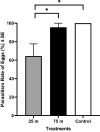Pollinator biological traits and ecological interactions mediate the impacts of mosquito-targeting malathion application
- PMID: 36220841
- PMCID: PMC9554017
- DOI: 10.1038/s41598-022-20823-2
Pollinator biological traits and ecological interactions mediate the impacts of mosquito-targeting malathion application
Abstract
Mosquito adulticides are perceived by the public as detrimental to nontarget arthropods, contributing to declines of native and beneficial insects. However, the actual impact of adulticides on nontarget arthropods in nature needs to incorporate biological and ecological elements. Here, we investigated the effect of biological/behavioral traits (butterfly roosting at different heights, roosting in sites underneath foliage, bumblebee hive usage) and interactions (parasitism, predation) of pollinators (butterflies and bumblebees) that could mediate the impacts of malathion application in manipulative semi-field experiments in Florida, USA. Roosting height from the spray route had a significant negative relationship with mortality of butterflies treated with ULV malathion, with high survival at the highest roosting height (7 m), but butterflies roosting among vegetation did not have higher survival. Bumblebees with hive access had significantly higher survival than bumblebees without hive access. Host plants treated with ULV malathion significantly reduced parasitism of monarch eggs by Trichogramma platneri, but increased predation of monarch caterpillars by Polistes paper wasps. These data provide insight into the realistic impacts of adulticide applications on pollinators in nature which will enable mosquito control districts to better limit nontarget effects of adulticide treatments and may help to address concerns related to potential nontarget effects.
© 2022. The Author(s).
Conflict of interest statement
The authors declare no competing interests.
Figures






Similar articles
-
Mortality and Cholinesterase Inhibition in Butterflies Following Aerial Naled Applications for Mosquito Control on the National Key Deer Refuge.Arch Environ Contam Toxicol. 2020 Aug;79(2):233-245. doi: 10.1007/s00244-020-00745-8. Epub 2020 Jul 1. Arch Environ Contam Toxicol. 2020. PMID: 32613299
-
Use of butterflies as nontarget insect test species and the acute toxicity and hazard of mosquito control insecticides.Environ Toxicol Chem. 2011 Apr;30(4):997-1005. doi: 10.1002/etc.462. Epub 2011 Feb 19. Environ Toxicol Chem. 2011. PMID: 21309017
-
Ground-Based Pyrethroid Adulticides Reduce Mosquitoes But Not Nontarget Insects in Central Florida.J Am Mosq Control Assoc. 2024 Sep 1;40(3):125-136. doi: 10.2987/24-7177. J Am Mosq Control Assoc. 2024. PMID: 38978491
-
Biopesticides and insect pollinators: Detrimental effects, outdated guidelines, and future directions.Sci Total Environ. 2022 Sep 1;837:155714. doi: 10.1016/j.scitotenv.2022.155714. Epub 2022 May 4. Sci Total Environ. 2022. PMID: 35525339 Review.
-
Ecosystem services provided by aculeate wasps.Biol Rev Camb Philos Soc. 2021 Aug;96(4):1645-1675. doi: 10.1111/brv.12719. Epub 2021 Apr 29. Biol Rev Camb Philos Soc. 2021. PMID: 33913243 Review.
Cited by
-
Changes in mosquito species and blood meal composition associated with adulticide applications.Sci Rep. 2023 Dec 12;13(1):22087. doi: 10.1038/s41598-023-49494-3. Sci Rep. 2023. PMID: 38086895 Free PMC article.
-
Laboratory and field assays indicate that a widespread no-see-um, Culicoides furens (Poey) is susceptible to permethrin.Sci Rep. 2025 Feb 8;15(1):4698. doi: 10.1038/s41598-025-89520-0. Sci Rep. 2025. PMID: 39922977 Free PMC article.
-
Pesticides impacts on human health and the environment with their mechanisms of action and possible countermeasures.Heliyon. 2024 Apr 4;10(7):e29128. doi: 10.1016/j.heliyon.2024.e29128. eCollection 2024 Apr 15. Heliyon. 2024. PMID: 38623208 Free PMC article. Review.
-
Exploiting Wolbachia as a Tool for Mosquito-Borne Disease Control: Pursuing Efficacy, Safety, and Sustainability.Pathogens. 2025 Mar 14;14(3):285. doi: 10.3390/pathogens14030285. Pathogens. 2025. PMID: 40137770 Free PMC article. Review.
References
-
- Kluser, S. & Peduzzi, P. Global pollinator decline: A literature review. Preprint at http://archive-ouverte.unige.ch/unige 32258 (2007).
Publication types
MeSH terms
Substances
LinkOut - more resources
Full Text Sources

